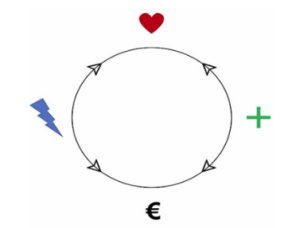Positioning
What is strategic positioning?
What is meant by “Positioning in marketing”?
What does StrategicPositioning involve?
Positioning processes with the Red Thread
What are bottlenecks in a company?
What are the benefits of target group analysis and target group consideration?
What does good sales have to do with good positioning?
What is brand positioning?
Positioning and corporate culture
Three principles for “good bridges” between positioning and corporate culture
Positioning
What is Strategic Positioning?
The word strategy derives from the ancient Greek word strategós, which means hill or mound.
In other words, strategy is all about gaining an overview from an elevated – possibly internal – position. To put it another way, it is about gaining a holistic perspective.
Strategic positioning is therefore about finding answers to the question of how your own company should be aligned in the best possible way in order to fulfill its purpos.
It is imperative to take both an “internal” and an “external” view here:
And one is – surprisingly often enough – reflected in the other and vice versa.
Is Positioning marketing?
In the literature, in classic business administration and in “business-speak”, the term is often used as if positioning is a sub-consideration in marketing.
This is not the case with positioning processes at Roter Faden Consulting – on the contrary, the opposite is true: here, marketing is actually “only” one of the final stages of a positioning process and is already part of the implementation.
What is meant by “Positioning in marketing”?
Positioning in marketing refers to the way
- how a company and its products are made visible in the marketplace.
- which marketing tools are used to achieve this.
- who or what is addressed, how and via which channels.
What does strategic positioning involve?
As explained above, this depends on which definition of positioning you use. In the “classic sense”, it is about the optimal use of marketing resources.
At Roter Faden / Red Thread Consulting, it is about much more. This is explained in detail in the sections below.
Positioning processes with the Red Thread at ‘Roter Faden Consulting’
At Roter Faden / Red Thread Consulting, we offer positioning processes for small and medium sized companies — which means from a one-person business to companies with around two hundred employees.
How does positioning work?
Strategic Positioning therefore begins – as mentioned above – by really climbing up the hill (strategós) and looking from above:
- What is the current state of affairs, what does the company currently offer?
- Where does the company come from, what was/is its mission and (current) direction?
- What is the current portfolio made up of?
- What are the company’s strengths?
- What makes it stand out in particular?
- Why does the company exist at all?
- Internal and external bottleneck analysis and review of the current positioning (if available)
- Target group analysis and linking of the ‘red threads’ developed up to this point
- Developing the most promising specialty area(s) and market analysis
- [if appropriate]: Analysis of necessary and helpful cooperation partners
- Profiling and implementation
- Regular review and, if necessary, adjustment or “fine-tuning”
What are bottlenecks in a company?
It is worth carrying out an in-depth analysis here in particular:
- What are the internal and what are the external bottlenecks?
- Communication is often mentioned – but what exactly does this mean? Where exactly is the bottleneck – internally or externally?
- Too few, too many or “the wrong” customers or clients?
- The right specialists?
- The right people in the right place? According to their inclinations and the requirements of the respective target area?
- How are the current products and/or services aligned?
- Are the needs of the desired target group being met?
You can also put it another way: What exactly is preventing the company from “flowing” and being (more) successful along the way?
What are the benefits of target group analysis and target group consideration?
This depends on the company’s FOCUS. The following can be roughly distinguished:
- Price focus: Business largely via lowest price
- Sales focus: Selling as much as possible at once
- Product focus: On the quality and especially the uniqueness of the product
- Customer focus: Best possible solution and satisfaction of customer needs
The Red Thread works almost exclusively for companies that have a customer focus.
Such a target group analysis and target group consideration brings focus:
“Someone who wants to do everything for everyone will soon do nothing for no one” is a coherent phrase in this context.
Only a focus on a specific target group enables sufficiently clear positioning. And only by analyzing the needs of the target group can the “right” products and/or services be found.
What do good sales have to do with good positioning?
A really good sales force would be better described as a “target group manager” or similar: These terms are now too worn out.
A sales force is really good and also successful in the medium to long term if it really gets to the bottom of the needs of interested parties and potential customers. And, in case of doubt, does not adapt them to its own products: Either it really doesn’t “fit” (in which case you can still recommend suitable solutions) or you succeed in adapting products and/or services precisely to the customer’s needs.
Good customer-oriented “reaching and convincing your own target group” requires good and appropriate positioning. On this basis and only on this basis (when building a house, you don’t start with the second floor first, but with the foundation!) can powerful next steps be taken … :
- Build relationship(s)
- Qualify customers (what does the customer want and above all need most? Most burning bottleneck?) with sub-stages
- Presentation (if necessary) (if you really can and want to do something for the customer)
- Conclusion (and what exactly does that mean?)
- Objections and how to deal with them
- Delivery of the product or service
- “After Sales” – Don’t just “disappear” again, but understand how the customer/client feels about the acquired ‘problem solution'(!)
Roter Faden Consulting supports you in this …
- With consulting to find the red thread through these topics
- With training in the individual stages of truly customer- and bottleneck-oriented sales
- With support through implementation and integration
Here is a brief look at the 5 aspects of successful positioning and how we look at it at Roter Faden Consulting:
First, the first four aspects in the following graphic:

In short: It is about solving the client’s bottlenecks () with the strengths (+) of the company and, if necessary, with the help of respective cooperation partners.
Beforehand, it is also important to take an honest look at your own bottlenecks and how they should be dealt with.
It is important to ask whether the company is doing what it likes to do (♥) and whether the current target group(s) are the desired target groups. .
In the south of the wheel (see diagram), financial aspects (€) come into play in another “ping-pong game”, such as whether and if so, how the desired or favorite target group is able to pay an appropriate price for these products / services and how the pricing should be structured.
The better and more specifically you focus on the benefits for your target group(s), the more good figures will follow – also in respect to your company’s financial results.
And finally, there is a fifth aspect:
What about the “ecology”, i.e. external conditions or the external environment?
Are my products/services suitable or do they need to be adapted?
How and to what extent is the business “resilient”, i.e. can it continue to operate well even in the event of unforeseen developments?
For further details and, above all, to find out whether and how this could be of interest to you and your company, please contact me at h.haefele@roter-faden-consulting.de – I look forward to hearing from you!
What is brand positioning?
In a way, brand positioning is the link between positioning and the development of an employer brand.
A positioning process can also involve one (or more) brands if the company wants to remain in the background with its own name as the sponsoring company.
This may make particular sense if the company wants to serve different target groups in different sectors.
The next step is then to make the brand(s) visible and position them favorably in the relevant submarkets.
In the relevant submarkets – this is where “marketing” comes into play, albeit in a broader sense of the word.
Positioning is optimal when the company is increasingly sought after – in other words
when it develops an attractiveness (= attraction) to the outside world:
- Clients come by themselves
- Good suitable staff come by themselves and want to collaborate.
Positioning and corporate culture
This is also about bridging the gap between positioning and branding:
A truly holistic positioning process will take into account the corporate culture or its development in its implementation.
This is not primarily a matter of developing some nice-sounding principles in workshops and putting them up on posters in all rooms (and then the issue is settled) – a frequently observed phenomenon.
Of course it makes sense to think about these things once (and hopefully involving as many as possible within a company), but the most important thing is that they are actually put into practice .
Three principles for “good bridges” between positioning and corporate culture can be identified in this context:
- There is a coherent strategic positioning, which in particular also answers the “WHY”: Why does this company exist and what benefits does it offer for its target group(s)?
- The corporate culture is aligned with the positioning.
All(!) employees know the above-mentioned “why” and know exactly what they (can) contribute to it in their area of work. - Consistency – both the strategic positioning and the corporate culture are implemented consistently and clearly.
